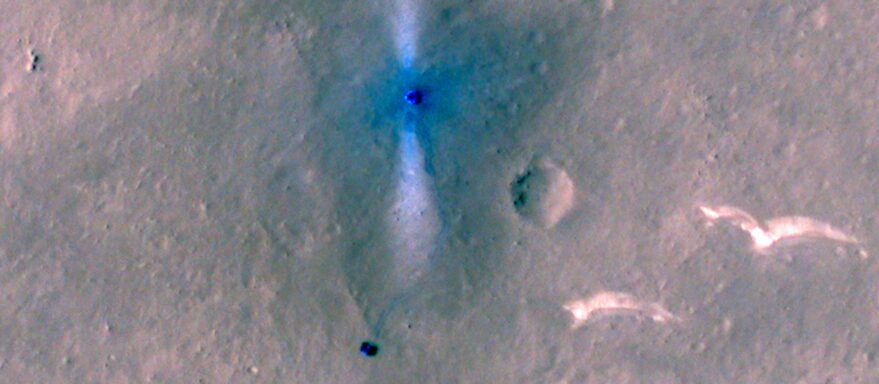HELSINKI — China has released landing process footage from its Zhurong rover as well as video and sounds of the vehicle roving on Mars.
Footage of the entry, descent and landing shows deployment of a supersonic disk-gap-band parachute, separation of the backshell, followed by powered descent, a hazard-avoidance hover phase, and landing.
The China National Space Administration (CNSA) published the footage in a Zhurong mission update early Sunday Beijing time. Video of the descent of the Zhurong rover from its landing platform, including sounds made by the vehicle’s egress, was included in the release.
The sounds were created by the metal on metal interaction of a rack and pinion system and recorded by Zhurong’s climate station, which intends to capture sounds of Martian winds.
Huge Zhurong update: Here's full footage of the Zhurong rover's EDL, showing parachute deployment, backshell separation, and landing, including very cool hover during hazard avoidance phase. [CNSA/PEC] pic.twitter.com/iWUXrFKf40
— Andrew Jones (@AJ_FI) June 27, 2021
“With the files we released this time, including those sounds recorded when our Mars rover left the lander, we are able to conduct in-depth analysis to the environment and condition of Mars, for example, the density of the atmosphere on the Mars,” Liu Jizhong, deputy commander of China’s first Mars exploration program, told Chinese media.
NASA’s Perseverance captured similar sounds of driving on Mars in March.
The 240-kilogram Zhurong rover successfully landed in Utopia Planitia on May 14. The deployment took place late May 21 Eastern, following a week-long series of checks and analysis of the environment.
The six-wheeled, solar-powered Zhurong has since covered 236 meters on the Martian surface. An undated panorama shows Zhurong and tracks leading back to the landing platform, along with surface and horizon features.
Zhurong had earlier dropped a remote Wifi camera when still close to the landing platform. The rover then returned to pose for a joint selfie with the lander. The new update this time featured footage of Zhurong’s drive back to the landing platform and later making a turn.
“Zhurong Rover is more independent in its driving on Mars [compared with China’s Yutu lunar rovers]. It can judge by itself whether there is a path ahead based on its own image analysis. It will make a judgment about every one meter in its driving, and move towards the target set by the ground,” Jia Yang, deputy chief designer of Tianwen-1 Mars probe, told CCTV.
Remember the remote camera that Zhurong dropped for the rover/lander selfie? It captured super cool footage of Zhurong driving away [CNSA] pic.twitter.com/6dGmLoMlMO
— Andrew Jones (@AJ_FI) June 27, 2021
The rover is part of the Tianwen-1 mission, China’s first independent interplanetary mission. Consisting of an orbiter, a lander, and a rover, Tianwen-1 launched in July 2020. It entered Mars orbit Feb. 10.
Zhurong is equipped with six science payloads, including a laser-induced breakdown spectroscopy instrument for analysing surface elements and minerals, panoramic and multispectral imagers, a climate station, magnetometer and a ground-penetrating radar.
It aims to return data on potential water-ice deposits, weather, topography and geology, complementing science carried out by missions from other space agencies.
The Tianwen-1 orbiter is currently in an 8.2-hour orbit, allowing a pass over Utopia Planitia once per sol to perform a data relay role. Zhurong has a primary mission and design lifetime of 90 sols (92 Earth days). It is currently unknown if Zhurong’s mission will be extended beyond this.
Tianwen-1 carries seven science payloads. It is expected to change to its dedicated science orbit with a period of 7.8 hours after supporting Zhurong.
The Tianwen-1 mission builds on technologies and capabilities developed through the Chang’e lunar program orbiters, lander and rovers. It also draws on head shielding and parachute expertise from Shenzhou human spaceflight endeavors.
Meanwhile NASA’s Mars Reconnaissance Orbiter revealed Zhurong’s progress with images captured with the HiRise camera June 6 and June 11. The images provided evidence of Zhruong’s driving activity in absence of regular updates from CNSA.

#Space | https://sciencespies.com/space/chinas-zhurong-rover-returns-landing-footage-and-sounds-from-mars/
No comments:
Post a Comment